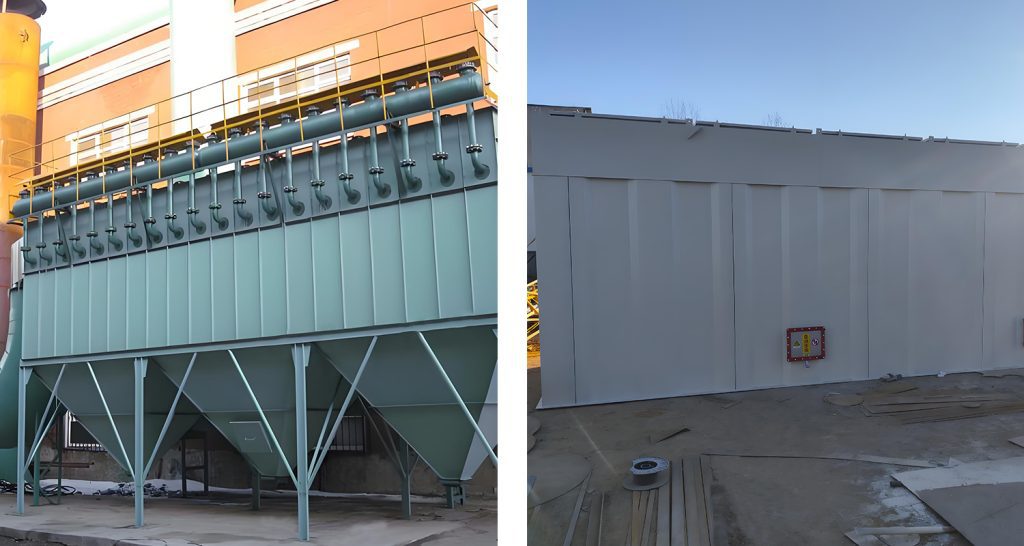Symptoms of Hopper Blockage
The main direct symptom is the ash conveying equipment below the dust collector fails to transport all the fly ash collected by the coletor de pó to the ash silo in real time. Many reasons cause this problem. For example, rapper hammers may fall into the pressure vessel, preventing discharge. Components like flow barriers may detach, blocking the hopper outlet and stopping ash flow into the pressure vessel. Moisture or condensation inside the dust collector can prevent proper ash flow. Also, insufficient air pressure in the conveying system, changes in coal quality increasing ash volume beyond design capacity, coarser ash particle size disrupting stable conveyance, or worn valves causing air leaks can lead to abnormalities. Typically, equipment issues allow quick part replacement and rarely cause severe hopper blockage. Therefore, if the hopper outlet is clear, the most likely cause of severe blockage is increased ash volume or coarser ash particles disrupting the system. This article analyzes adjustment methods and procedures for the conveying system when hopper blockage occurs, aiming to help resolve it quickly.
Methods for Handling Blockage
01. Handling Blockage Caused by Increased Ash Volume
When hopper blockage occurs, first identify the cause. Then, apply targeted solutions. Otherwise, a vicious cycle forms: “blockage – emergency unloading – re-blockage”. For blockage from increased ash volume (e.g., due to equipment failure, hours of maintenance causing ash buildup, or poorer coal quality exceeding system capacity), ensure “high pressure without tripping” and that the system empties the hopper quickly. Generally, follow this emergency plan to resolve hopper blockage rapidly:
(1) If a high-level alarm in a dust collector hopper persists for 20 minutes, the shift operator must immediately report it to the relevant emergency response departments (usually Maintenance, Operations, and Repair teams). The emergency commander (typically the dust/ash removal specialist) then activates the emergency plan.
(2) The repair team immediately dispatches personnel. They first check the pressure vessel’s discharge status to verify if the high-level alarm is real and if ash accumulation exists inside the hopper.
(3) If the hopper level gauge is falsely alarming, calibrate its sensitivity. After calibration, report to all emergency response departments. The commander decides whether to terminate the plan based on the situation and notifies all departments.
(4) If ash accumulation is confirmed, immediately initiate the following measures:
① The repair team inspects the pneumatic conveying equipment for the blocked hopper. They check the seal condition of the inlet, balance, and outlet valves. They assess the fluidizing device in the pressure vessel. They verify all air inlet valves function correctly. They check the vessel’s discharge status and level gauge alarms. They confirm the original conveying parameters remain unchanged. If no issues are found, report immediately to the commander. The commander then initiates the next step. If problems are found, fix them immediately. After repairs, report to the commander. The commander then notifies relevant departments to observe and analyze the conveying operation and output, deciding whether to terminate the plan or proceed.
② Increase the total conveying air volume to speed up transfer. Simultaneously, check if the air source pressure is sufficient. If pressure is insufficient, stop the ash conveying system for the downstream electric field. This concentrates air volume to clear the high hopper level quickly. Restore original settings when the plan terminates.
③ Check if the balance pipe is clogged. A clogged balance pipe hinders vessel discharge. If clogged, disconnect the flange between the balance pipe and valve. This allows air inside the vessel to vent during filling, ensuring smooth material intake. Once the high level clears and the system feeds smoothly, report to all departments. The commander decides whether to terminate the plan and notifies all departments. Upon termination, reconnect the balance pipe and valve, and promptly clean any accumulated ash around the vessels.
④ If the vessel still fails to discharge after disconnecting the balance pipe flange, activate the emergency unloading device immediately. This quickly removes accumulated ash from the hopper. Once the high level clears and the system feeds smoothly, report to all departments. The commander decides whether to terminate the plan and notifies all departments. Upon termination, reset the emergency unloading device and promptly clean all accumulated ash.
⑤ After resolving the high hopper level and terminating the plan, all involved departments analyze the cause. They promptly address or rectify any potential issues or abnormalities.
02. Handling Coarser Ash
When the electrostatic precipitator is out of service, the hopper collects only heavier, coarser ash that settles by gravity. Conveying this settled ash requires a final velocity of 18-20 m/s, demanding high air volume. However, significantly increasing air volume accelerates pipeline wear and severely impacts the system’s air source pressure, causing instability and sharp drops. Furthermore, insufficient backup air compressors might prevent reaching the required air volume. Consequently, pipeline blockages occur frequently. When a blockage happens, the automatic clearing program usually activates. But because settled ash is coarse and heavy, clearing takes a long time. During extended clearing, the system cannot convey normally, severely reducing output. In such cases, personnel often manually open the hopper’s emergency unloading port to discharge the settled ash. This not only causes serious environmental pollution and safety hazards but also consumes significant manpower and resources during cleanup and transport.
To address this, adopt a material plug conveying method. Adjust parameters promptly to achieve stable conveyance without drastically increasing air volume. This ensures the system meets the settled ash volume demand and empties the hopper quickly. Specific methods are:
(1) Appropriately increase the pipeline blockage pressure setting closer to the air source pressure. This primarily raises the static pressure in the pipeline, pushing material plugs of a certain length to the destination. It also avoids safety hazards from high-pressure airflow during unclogging that might affect ash-filled hoppers.
(2) Modify the operating process. The aim is to control the length of each material plug entering the pipeline and the total length of all plugs within it. Key measures include adjusting the primary, tertiary air, and outlet valve operations based on real-time pipeline pressure feedback during conveyance. This controls individual plug length and the total plug length in the pipeline, thus preventing blockages, ensuring stable conveyance, and improving efficiency.

Conclusions
(1) When hopper blockage occurs in a dust collector, avoid blindly using emergency unloading. This approach causes serious environmental pollution, consumes significant manpower and resources, and poses major safety risks.
(2) When hopper blockage occurs, first analyze whether the hopper outlet is blocked by foreign objects. If so, perform emergency unloading immediately after ensuring safety measures are in place. If not blocked by foreign objects, quickly make targeted adjustments to the conveying system based on the ash volume and particle size. Adapt the system to the current ash characteristics, ensuring the conveyed ash volume exceeds the amount collected by the blocked field in the dust collector. Thus, adjustments to the conveying system can quickly resolve the hopper blockage.

